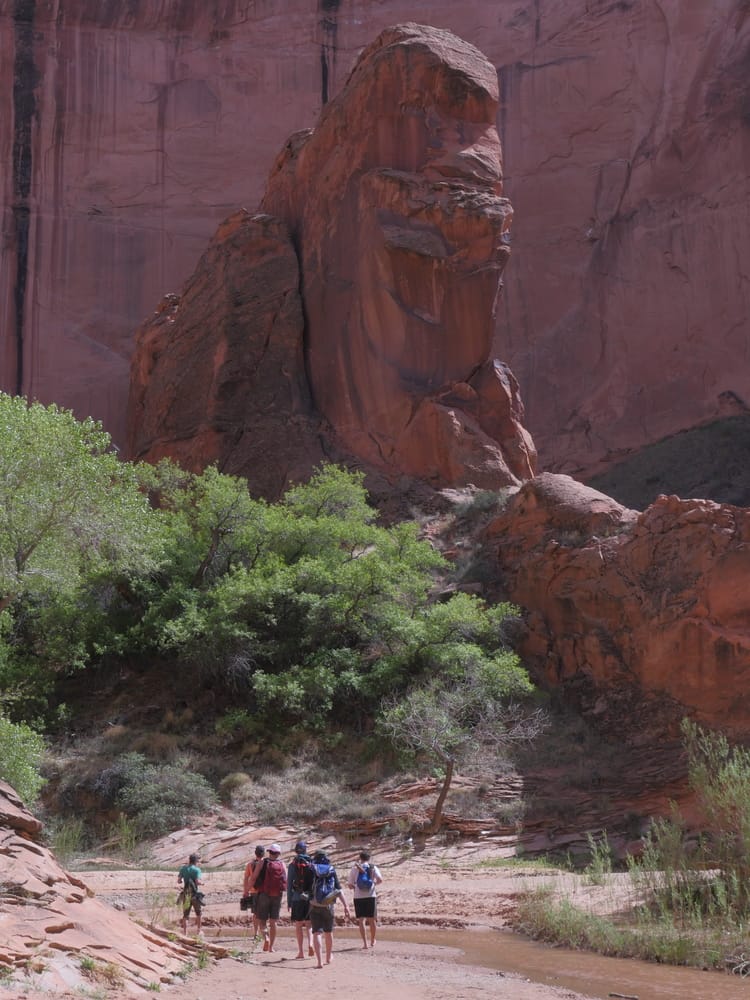
Backpackers in Coyote Gulch, part of the Grand Staircase-Escalante.
Joe Biden moves into the White House in four days. Until then, President Donald Trump has a brief window to make significant changes to public land designation before the Biden administration takes office.
It wouldn’t be the first time. In 2017, the newly appointed President Trump signed a legally questionable executive order decreasing the acreage of two national monuments in Utah: Bears Ears and Grand Staircase-Escalante. When other public lands were tapped for “review”, our National Monuments appeared at risk of simply being written away.
In my opinion, president-elect Joe Biden shouldn’t undo those executive orders.
Congress should.
Monument Men
For those familiar with Schoolhouse Rock, most laws begin life as a bill, sitting on capitol hill. Executive orders are essentially laws that circumvent that legislative process, issued directly by sitting presidents. National Monuments are created largely by presidential proclamation, for example.
The unusual power to make National Monuments stems from the 1906 Antiquities Act. The act empowered then-president Teddy Roosevelt to do what congress seemed unwilling to do: set aside millions of acres of land from the hands of industrial monopolists.
In the following 114 years, presidents of both parties have made use of the act, creating public lands like Devil’s Tower and Craters of the Moon. Legislators turned many existing monuments into National Parks, like Zion and Grand Teton.
The political norm was that National Parks and Monuments, once created, were set in stone, destined for our descendants. The 2017 monument reductions upended that belief*, and opened the Pandora’s box of deregulation and privatization. What went wrong?
A Park Too Far?
In 1996, Bill Clinton proclaimed the Grand Staircase-Escalante National Monument (GSE), a behemoth 1.7 million acre monument in southern Utah. Environmentalists hailed the decision, but it enraged locals, and provided the perfect fuel for the federal deregulation crowd.
High Country News reported in 1996:
“…the battle over wilderness has raged for more than a decade here. County commissioners sent bulldozers into proposed wilderness areas one Fourth of July, wilderness supporters have been hung in effigy and environmentalists have decided that compromise and consensus are dirty words. It remains to be seen whether the designated monument will heal Utah’s environmental war, or prolong it.”
Before the park my husband was a miner. No longer.
Twenty-four years later, the evidence is clear: Utah’s environmental war continues. In large part because the Clinton proclamation was the perfectly wrong way to create a monument.
Utahns claimed they hadn’t been part of the decision making process. Without public testimony or congressional hearings, plans for GSE must have taken place hidden within the Clinton administration. Senior Utah Senator Orrin Hatch infamously called it “the mother of all land grabs.” Utah Representative Bill Orton wrote legislation to undo the designation, to no effect.
And the announcement itself? Clinton unveiled GSE from the Grand Canyon in Arizona, with no Utah representatives present.
Of course, one can’t overlook the financial incentive. On a drive to the canyons of Escalante, a local shopkeeper told me bluntly, “Before the park my husband was a miner. No longer.” The sentiment was the same in 1996 when Utahns saw GSE as a massive block to mining revenue, and a threat to state education funding. The Kaiparowits Plateau, at the very heart of the park, is home to massive coal deposits estimated at over 400 billion dollars.
The economic impact of National Monuments in literature is mixed. Coal is on the way out, and ranchers maintain access to public land since Latter-Day Saint settlement. But the numbers obscure a meaningful criticism of public lands: excess executive power. The opponents of GSE in Utah weren’t upset about a monument. They were upset about a monument created by a president in their communities without their consent.
Even in the de-regulatory zeitgeist of the 80s and 90s, however, presidents and congress alike remained unwilling to delist monuments, even controversial ones.
Environmentalists took an easy win. But twenty years later, anti-regulation, anti-environment, and anti-federal power advocates would get their surrogate in the White House: Donald Trump.
Grabbing a Bear by the Ears
After the 2016 election, a coalition of southwestern Tribes and environmentalists made a last-ditch effort to get public lands on Obama’s desk before the Trump transition.
Activists hoped Bears Ears National Monument would protect the cultural heritage of these Tribes, as well as the diverse landscape and ecology of southeastern Utah. President Obama declared it on December 28, 2016.
This time, Utah conservatives were ready. Senator Hatch, in his final years in the Senate, approached President-elect Trump about monument reductions. Mike Lee, the junior Utah Senator, drafted legislation to remove millions of acres from federal coffers, under the questionable motive of states’ rights.
In December of 2017, Trump annexed two million acres from Grand Staircase and Bears Ears, destined for intensive mining operations. The White House tapped several more western monuments for review.
Activists responded to the reductions with lawsuits. Senator Mike Lee’s attack on public lands was opposed powerfully and immediately by his own constituents. The antiquities act became the subject of debate—the act permits presidents to make monuments, but does it allow them to reduce them? Eliminate them?
The courts will answer those questions if the Biden administration doesn’t answer them first.
Big Act, Little Act
President Obama’s achieved the bulk of his legacy (sans Affordable Care Act) through executive order. Consequently, most of Obama’s legacy has been undone.
The Joe Biden administration seems set to change course on governing federal agencies, and they should. But how will they create monuments and laws that last more than one administration?
There is hope, but not in the executive branch. In the last few years, there have been encouraging signs of a new coalition of pro-wild legislators in both parties.
Three legislative wins took place in the Trump era:
- America’s Conservation Enhancement Act (Oct. 30th, 2020)
- Great American Outdoors Act (August 4th, 2020)
- John D. Dingell Jr. Conservation, Management and Recreation Act. (March 12, 2019)
Each of these acts made significant headway in keeping existing federal systems working, like funding the National Park Service, the Land and Water Conservation Fund, and reauthorizing the North American Wetlands Conservation Act. The Great American Outdoors and John Dingell Jr. Acts designated new wild and scenic rivers, wildernesses, and a national monument.
How did these wins happen?
A Park Grows in Utah
The beleaguered Beehive State provides a perfect example: the Emery County Bill of 2019.
The bill was the work of the Southern Utah Wilderness Alliance (SUWA). SUWA worked for over a decade on the bill, reaching out to Tribal Nations, landowners, and county and state representatives as they found common ground for wilderness designation in red rock country. They also took decisive measures to oppose versions of the bill that did not include wilderness protections.
The final bill didn’t protect every area wilderness supporters wanted, but compromise and local support made it possible to protect anywhere at all.
Congress attached the Emery Bill to the growing John D. Dingell Jr. Act in early 2019, . The Dingell Act was an omnibus bill, a conglomerate of smaller, pre-written bills, in order to streamline the legislative process. Drafters created a sprawling act, with just about every western state involved, and enough bipartisan support to sail through congress and give an enormous win to the environmental movement.
If that’s what it takes to pass bills in a time of division, then we better keep doing it.
Looking Forward
Relying on the president to take the ball at overtime simply won’t work anymore. Future opponents to public lands and environmental safeguards will be much more focused and effective than Donald Trump, or secretaries Zinke or Bernhardt.
The only sustainable path forward is also the hardest—to pass bipartisan legislation before more damage is done.
Congress needs to govern, or we will govern them. After the tumult of the Trump administration, it is clear that we can only make that possible by doing the work of stewardship ourselves. We can bridge divides, make compromises, and take bold action in our own counties. If the honest work of everyday people isn’t enough to save our monuments, then they cannot be saved.
“The idea of wilderness needs no defense, it only needs defenders,” as Edward Abbey said.
We’ve done it before; it’s time America does it again.
*President Wilson reduced the size of Olympic National Monument, but the current size of Olympic National Park includes those formerly reduced acres.
